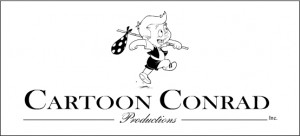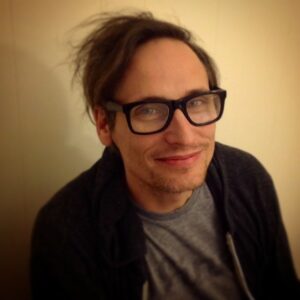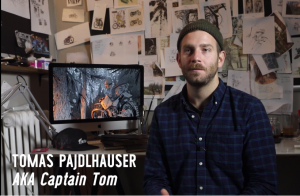 Repeated contributor, Mr Mark Capello(in bold), recently sat down with Luke Conrad and Adam King, the principals at Cartoon Conrad in Sackville NS. The three discuss animation, the growth of Cartoon Conrad, Jesus, and Simon Cowell.
Repeated contributor, Mr Mark Capello(in bold), recently sat down with Luke Conrad and Adam King, the principals at Cartoon Conrad in Sackville NS. The three discuss animation, the growth of Cartoon Conrad, Jesus, and Simon Cowell.
I just want to start this interview by asking you guys about Cartoon Conrad, what are the types of things you do, and how long have you been around?
LC – I started the company in 2003, but we didn’t get our first studio space until 2004, so it was basically me in a room for a year or two. Going crazy. And, after being broke for two years, I started to get in a little bit of work and then Adam came along, and from there we’ve basically just been slowly growing. We’re now on our second season of Razzberry Jazzberry Jam and we do a lot of broadcast animation. Being a company that’s been around for 5 years or so, we’ve done a lot of web work, online stuff, training modules, a lot of design… we’ve had our hands in all sorts of media I guess.
AK- It’s all about keeping yourself afloat really.
LC – Yeah, anything that would bring us money in for the first few years.
So, what did you guys do beforehand, like where did you work before you had your own company?
LC – Myself, I actually went to the Digital Animation course in Truro Nova Scotia, and I was there for a year before I was picked up by Collideascope. Ron Doucet actually pulled me on and I worked with him for 6 months on a show called ‘Olliver’s Adventures’. From there I went to be a lead animator on ‘Doodles’ at Trapeze Animation. From there I worked with you, at Helix, then with Brian Finley at Wetsand for a bit. That’s kind of when I decided to throw myself into Cartoon Conrad. I decided to get a room, then work out of the upstairs of a church and just went at it.
What about you Adam?
AK – For me I started at Truro like Luke, that’s actually where we met each other. From there out of school it was one of those down periods so I had about a year there when I was doing ‘whatever’… and whatever being washing dishes or bagging groceries. Luke came to me and he had a little pilot he was trying to get some of his buddies together to get it done. I started just going into Collideascope and working on it there, because it was free there to just work on the computers… I treated it like a normal job putting in the hours, and then I would go work at a restaurant at night.
 Now this was during a downtime at Collideascope? I always thought it was great that they would let people come in and work on the studio equipment for free to work on whatever they wanted to. (Another reason Collideascope was so important to the region).
Now this was during a downtime at Collideascope? I always thought it was great that they would let people come in and work on the studio equipment for free to work on whatever they wanted to. (Another reason Collideascope was so important to the region).
AK – Yeah, I was treating it like a normal job, going in at 9 and staying to 5. I guess Ron Doucet saw my dedication, because he made me a clean-up artist on their next project ‘Farzzle’s World’. I ended up staying for 5 or 6 projects at Collideascope… actually when the industry was probably at it’s busiest for whatever reason I thought ‘okay I’ll go work for Luke now’.
It’s interesting just how inbred this region is, you end up working with everybody who’s worked with everybody for every other company. I remember Luke you were a Co-op student of mine at Helix animation when you were still in school shortly after I moved out here. We lived one street away from each other in the same redneck little town, and you would always come over and knock on my door and we would have some animation conversations. It’s a small region. So, what are you guys working on now?
AK – Well the main thing is pre-production for the second season of Razzberry Jazzberry Jam, and we got some online training modules as well, which are nice because they don’t stick to the usual broadcast schedule. Those web projects are small, they may only employ 3-5 people for 2-3 months but they help fill the gaps.
How big will the full crew be on Razzberry Jazzberry Jam and these other smaller projects?
LC – We’ll be up to about 26 people here, and we’ve got some other small things coming in waves, so we can go up from there.
AK – We’ve got 26 or 27 guaranteed spots until the end of February, if it’s more than that it will be because we got more work in.
Which would be a good problem to have. You guys have just moved into your funky new space and we’re actually doing this interview from inside a sauna that happens to be in your space… an actual sauna that smells like old men in towels. It’s a great space.
AK – Yeah I think it’s a cool creative little spot.
LC – Yeah I probably looked at 30 different spots in the Bedford and Sackville area, and when I saw this spot I thought ‘We could do cartoons here, we could draw here’ a lot of spots were industrial spaces with one big open room, and you’d have to get dividers, and I just wasn’t feeling it. If you have a creative atmosphere people can really enjoy their work.
Why specifically Sackville? I know you grew up here, but Halifax is only 20 minutes away by car, so is Dartmouth. I mean, you’re far enough out of town to be out of town, but not far enough to take advantage of the regional bump to the provincial tax credits. Any particular reason you chose Sackville.
LC – It started off where I knew the person that gave me our first office.
And that was Jesus right?, because your first office was in a church.
LC – Yes, that’s right it was Jesus. That office was only 10 minutes away from my home, and it was just me really.
But it wasn’t just you Luke, when you look back and see that single set of footprints in the sand… that was when Jesus carried you.
LC – Hahaha. So, after it was just Jesus and I for two years… you know what? I just grew to love the area and it was kind of nice to not be in Halifax. And actually as the crew started to come here, they were scared at first, but after they realized they’re going against all the rush hour traffic here and back, there are plenty of places to eat and things to do.
That was one of the biggest complaints I heard from people when you were crewing up for Razzberry Jazzberry Jam was “Uhhh it’s in Sackville”. I think people had set up their apartments and lives around all the major Halifax/Dartmouth based studios. To get on a bus and commute was something else to consider for them.
LC – I think everyone’s happy, and they can tell people they work in ‘Sackville’ right beside ‘Beaverbank’, I mean c’mon those are some cool names.
You guys have gained a reputation in the region for being THE best studio to work for, reasonable workloads, good pay, weekends off, good working environment… how did you guys manage all THAT?
LC – Shucks! Ummm, you know that’s really nice to hear, we just try to treat our artists the way we’d want to be treated, we’re both animators ourselves. Luckily enough we’ve started something that’s picked up and has brought in work so I guess we just do what we want, and what we know is right, we try to treat people the way we’d like to be treated.
AK – Yeah, basically put yourself in someone else’s shoes, just stuff like making sure that they’re taken care of in terms of EI, making sure that they don’t get burned out after two weeks and never want to come back into the place.
LC – And you know what? It pays off for us because for Razzberry 2 we have the exact same crew we had for Razzberry 1, and it’s really unheard of to get back the exact same crew and everyone wants to come back. It makes a big difference for us because we’re not training people on a new show, we know everyone, they’ve worked on the show, they’ll be able to just slide into the work again.
It’s critical because usually there is a bit less money for a second season, I think the producer assumes it should be easier to complete a second season after you’ve completed the first, but if you lose your crew, it’s not always the case.
LC – Yeah, and big props to Trapeze Animation on Razzberry as well, because this isn’t something they just want to get out, they want to create a great product, a really high quality product. They are allowing us to be able to do this, so with both of our teams coming together to try to create something that’s really high quality it really does make a difference for everyone. Everyone wants to work on something like that.
Now how did you attract that contract? Obviously you had worked for Trapeze before, so they were aware of who you were, but at the time you didn’t exactly have a huge crew to unleash upon a full sized project. Did you have to do anything special or outside of the box to attract the attention of Trapeze to consider you guys as the animation production studio.
LC – You know, I’d like to think that I worked hard for them when I worked for Trapeze on Doodles, I put a lot of effort into it. Later on, when I started the company, we had a number of smaller shows and web stuff under our belts, and when they realized they were going to outsource some stuff, they thought of me. The first thing they outsourced was actually Doodles, and it was a small chunk, so I think they thought “Hey let’s see what they can do”.
You didn’t have to do any Spec work, you didn’t have to do a test or five minutes for free to show them you guys could handle it?
LC – No, they trusted us, and where I’d worked on Doodles as a lead I knew the show well, so they wanted to put their faith in us and we came through. From there they were really happy with the product, and we got it done on time and on budget. When Razzberry came along it was obviously a much bigger project, they decided to just give us the rough animation, and we did a good job in assembling the pre-production so they decided to give us the clean-up as well.
I had heard they were originally going to be sending the Flash clean-up overseas, but you guys did such a good job that they kept it here domestically.
AK – At one point we were only going to be doing the posing.
LC – Yeah, that’s right, our first conversation was ‘just posing’ and that quickly went to animation.
AK – They took a big risk on their part to go with us, and I’m so grateful for that, but I think we did right by them as well.
In the future, what type of project would you like to specialize in at Cartoon Conrad?
AK – I hear it from Luke almost every day, “get some big deal commercials coming in”.
LC – Yeah, I think both Adam and I are very passionate about animation, so we’d love to get some projects in like commercials that could lead into feature films into the future. You know with commercials you usually get a better budget and you can spend more time on it and really put a lot more effort into it… more so than with regular television. I think our next step would be to start moving into commercials and more high-end animation.
What computer programs/techniques do you apply to your work?
AK – It pretty much just boils down to Flash for 98{f2e86ea6af82e2bb048871abf045622abf0ed27fb513932dc1ee8c05a54cbefd} of everything.
You don’t use After Effects, or any 3D?
AK – Generally it’s a case by case basis, I mean we’ll add other programs to the repertoire but it all comes through Flash.
You’re essentially a Flash studio, but in the future if you’re imagining doing more high-end animation do you imagine you will fit that into the Flash constraints or do you imagine going back to a paper reality?
LC – We’re actually talking about that right now, obviously we’ll never give up Flash, but it might be an option in the future to bring back the old animation disks and see what we can do there. I guess you can do the same style of work in Flash as on paper, but there’s still something different about it and we want to be able to offer the paper service to our clients.
Where would you like to see Cartoon Conrad in 5 years?
LC – I personally would love to get into co-producing or producing our own creations, we’re always creating, we have our own ideas and as animators it’s hard not to, it’s natural. We’d love to be able to push our own ideas out there and see them come to life and get some funding.
What’s this rumour I’ve heard that you’ve personally appeared on American Idol and Canadian Idol Luke?
LC – Hahaha it’s all a lie, yeah I have a comedy duo on the side called ‘Luke and Jock’ and we do it just for fun. I think most animators and artists seem to have ‘other’ things in their lives, painting or sculpting. We have a number of artists here that knit in their spare time, they’ve got their own knitting club, but generally most artists have other things in their lives that they’re great at…
AK – You’re just great at making an ass of yourself.
LC – Yeah, exactly, and Adam is actually part of that knitting club…
AK – I started that knitting club!
LC – So anyway, that’s just my thing, in my spare time we try to hit reality TV and make fools out of ourselves.
You guys are a musical duo.
LC – Yeah!
And did you actually get air time on American Idol?
LC – No. Canadian Idol we did really well and got on TV, American Idol we battled 17,000 people in New York and made it down to the top 100, and after 5 auditions we finally got to audition in front of Simon and the gang. Simon HATED us, and we ended up not getting on TV… it was too bad, but we’re Canadian so we wouldn’t have been eligible on American Idol anyways, we just snuck in. We actually just did an appearance on the show ‘The Dragon’s Den’ and it should air in the fall or winter on CBC.
That’s a fun side project, making a fool of yourself on reality TV.
LC – It’s something I’m pretty good at.
Thanks so much for your time and the interview guys, and thanks for the use of your sauna, it was wonderful.
LC – Yeah no worries, maybe next time you could wear some clothes.
Big thanks to Mark for taking the time to put this together, and thanks as well to Luke and Adam for tolerating Mark’s sweaty nakedness and sharing with the site.
m




This is great. I remember taking the bus into Sackville to work at the church and it was a lot of fun. Congrats to Luke for sticking to it and making a success of things. I hope I get to see the new studio some day!
One of the things I found really interesting in this piece was the light it shed on the role Collideascope really played in the region. I’ve heard recaps and testiomonials to the company before, but it’s becoming apparent just what this one company, and the way in which it was run, did to build the industry out east. Here in Ottawa we suffered from a competitive protectionism for a long time that sometimes prevented studio owners from ever even sitting at a table together. It sounds like Colideascope really believed that an open door, collective, and suportive approach was good for business. Beyond that, not only did they believe it, but they seem to have practiced it too.
Collideascope casts a large shadow here on the East Coast. They had their share of protectionist behaviours, and they were often cold to their competitors. One of the owners had a particularly defensive approach to competitors (and there are a few nasty anecdotal stories that go with that reputation), but the real heroes of the positive culture are M-A Kuttner, and Ron Doucet. M-A has always been supportive of local animation, and he was very quick to lend advice or a hand to all the growing newer studios in the region. He would take their calls and mentor them in any way he could. Ron didn’t seek company approval to foster a positive attitude in the community, he just did it. He invited artists and owners from local companies to the monthly Collideascope production parties, he forwarded crew names to competitors for hiring purposes when Collideascope was on downtime, and he kept an open door policy for the equipment during downtime allowing graduates and competitor’s employees to work at Collideascope on their own or in community collaboration. That is just for starters, Ron is a Saint in our region. On the East Coast we collectively owe both of these regional pioneers a great debt. They will hopefully inspire our current positive, collaborative, and inclusive attitude to carry on a long time.